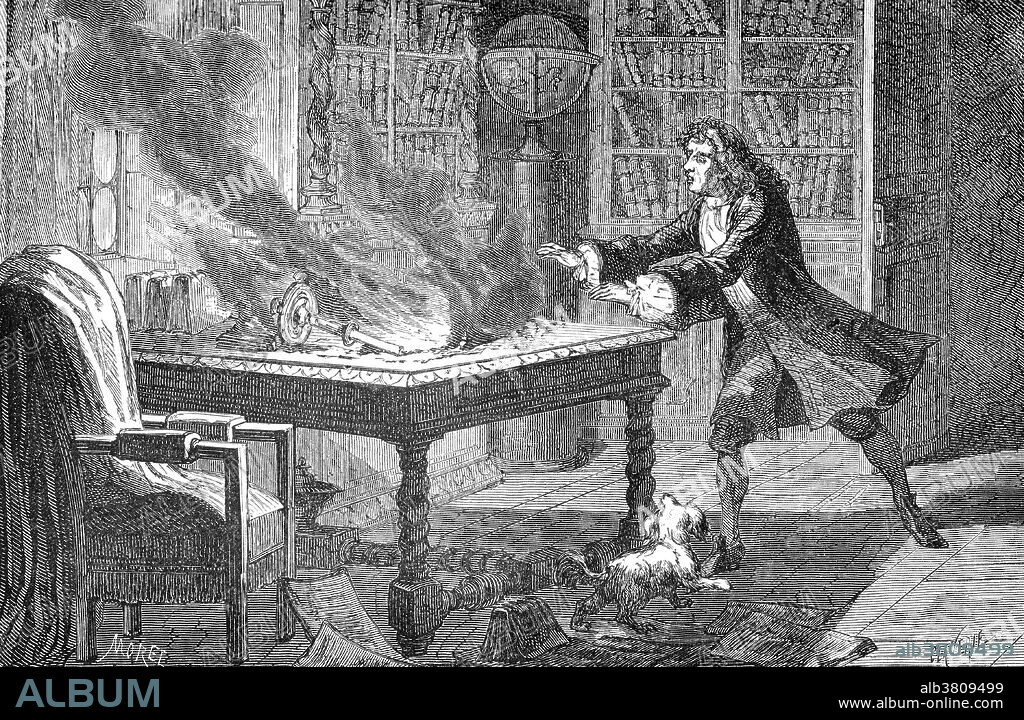alb3809499
Isaac Newton's Lab Fire, 18th Century

|
Add to another lightbox |
|
Add to another lightbox |



Title:
Isaac Newton's Lab Fire, 18th Century
Caption:
Diamond was, according to legend, Newton's favorite dog, which, by upsetting a candle, set fire to manuscripts containing his notes on experiments conducted over the course of 20 years. Newton is said to have exclaimed: "O Diamond, Diamond, thou little knowest the mischief thou hast done." According to another account, Newton simply left a window open when he went to church, and the candle was knocked over by a gust of wind. Isaac Newton (December 25, 1642 - March 20, 1727) was an English physicist, mathematician, astronomer, natural philosopher, alchemist, and theologian. His monograph Philosophae Naturalis Principia Mathematica, published in 1687, lays the foundations for most of classical mechanics. In this work, Newton described universal gravitation and the three laws of motion, which dominated the scientific view of the physical universe for the next three centuries. The Principia is generally considered to be one of the most important scientific books ever written. Engraving from "Vies des savants illustres" by Louis Figuier.
Credit:
Album / Science Source
Releases:
Model: No - Property: No
Rights questions?
Rights questions?
Image size:
4650 x 3030 px | 40.3 MB
Print size:
39.4 x 25.7 cm | 15.5 x 10.1 in (300 dpi)
Keywords:
17TH CENTURY • 18TH CENTURY • 18TH CENTURY, THE • 18TH • ALCHEMIST • ALCHEMY • ALCHEMY, ALCHEMIST • ART • ARTWORK • ASTRONOMER • ASTRONOMY • BW • CELEBRITY • CLASSICAL MECHANICS • DEVELOP • DIAMOND • DIFFERENTIAL CALCULUS • DOG • DRAWING • ENGLISH • ENGRAVING • EUROPEA • EUROPEAN • FAMOUS • FIGUIER • FIGURE • FIRE • HISTORIC • HISTORICAL • HISTORY • ILLUSTRATION • ILLUSTRATIONS • IMPORTANT • INTEGRAL CALCULUS • ISAAC NEWTON • KNIGHTED • LAB • LABORATORIO • LABORATORY • LABORATORY; LAB • LAW OF GRAVITY • LOUIS FIGUIER • MALE • MAN • MATH • MATHEMATIC • MATHEMATICAL • MATHEMATICIAN • MATHEMATICS • MEN • NATURAL PHILOSOPHER • NEWTON • NOTABLE • PEOPLE • PERSON • PERSONALITIES • PERSONALITY • PET • PHILOSOPHAE NATURALIS PRINCIPIA MATHEMATICA • PHILOSOPHER'S STONE • PHYSICIST • PHYSICS • POLYMATH • PRACTICAL REFLECTING TELESCOPE • REFLECTING TELESCOPE • REFLECTOR TELESCOPE • SCIENCE AUTHOR • SCIENCE WRITER • SCIENCE • SCIENTIFIC REVOLUTION • SCIENTIST • SIR ISAAC NEWTON • THEOLOGIAN • THEORIST • THEORY OF COLOR • THEORY OF COLOURS • VIES DES SAVANTS ILLUSTRES • WELL-KNOWN
 Pinterest
Pinterest Twitter
Twitter Facebook
Facebook Copy link
Copy link Email
Email

